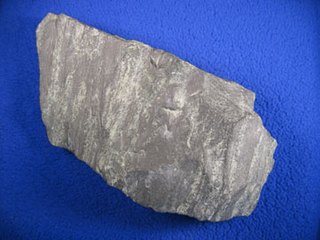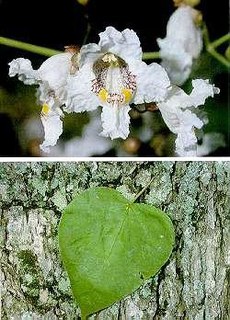
Iron Range refers collectively or individually to a number of elongated iron-ore mining districts around Lake Superior in the United States and Canada. Despite the word "range," the iron ranges are not mountain chains, but outcrops of Precambrian sedimentary formations containing high percentages of iron. These cherty iron ore deposits are Precambrian in age for the Vermilion Range, while middle Precambrian in age for the Mesabi and Cuyuna ranges, all in Minnesota. The Gogebic Range in Wisconsin and the Marquette Iron Range and Menominee Range in Michigan have similar characteristics and are of similar age. Natural ores and concentrates were produced from 1848 until the mid 1950s, when taconites and jaspers were concentrated and pelletized, and started to become the major source of iron production.
US Highway 141 (US 141) is a north–south United States Numbered Highway in the states of Wisconsin and Michigan. The highway runs north-northwesterly from an interchange with Interstate 43 (I-43) in Bellevue, Wisconsin, near Green Bay, to a junction with US 41/M-28 near Covington, Michigan. In between, it follows city streets in Green Bay and has a concurrent section with US 41 in Wisconsin. North of Green Bay, US 141 is either a freeway or an expressway into rural northern Wisconsin before downgrading to an undivided highway. In Michigan, US 141 is an undivided highway that runs through rural woodlands. The highway has two segments in each state; after running through Wisconsin for about 103 miles (166 km), it crosses into Michigan for approximately another 8 miles (13 km). After that, it crosses back into Wisconsin for about 14 1⁄2 miles (23 km) before crossing the state line one last time. The northernmost Michigan section is about 43 1⁄2 miles (70 km), making the overall length about 169 miles (272 km).

RiverSculpture! are public art displays found along the Milwaukee Riverwalk in downtown Milwaukee, Wisconsin. Information kiosks stationed near each presentation offer self-guided walking tours of this annual outdoor exhibition.

The Bay View Historical Society was established in 1979 to preserve the character and heritage of the neighborhood of Bay View in Milwaukee, Wisconsin.

The Victorious Charge is a public artwork by American artist John S. Conway located on the Court of Honor on West Wisconsin Avenue in downtown Milwaukee, Wisconsin, United States. The 1898 bronze sculpture is 9'10" high and sits on a 20' square granite pedestal.
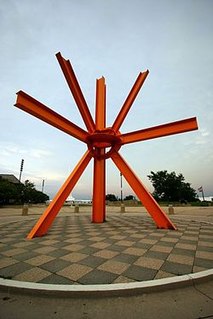
The Calling is a public artwork by American artist Mark di Suvero located in O'Donnell Park, which is on the lakefront in Milwaukee, Wisconsin, United States. The artwork was made in 1981-82 from steel I-beams painted an orange-red color. It measures 40 feet in height, and it sits at the end of Wisconsin Avenue in front of the footbridge that leads to the Milwaukee Art Museum.

Celebrating the Arts is a public artwork by Indian artist Narendra M. Patel located at the Roosevelt Creative Arts Middle School, which is in Milwaukee, Wisconsin, United States. The sculpture is an abstract form created from over two tons of steel sheets welded together. It is 20' high x 14' wide x 6' deep and was constructed in 1989.

Spirit of Commerce is a public artwork by German artist Gustav Haug located in Jackson Park, which is on the south side of Milwaukee, Wisconsin, United States. This zinc sculpture is 15 feet tall and sits on a red granite pedestal near the park's lagoon. It is the oldest public sculpture in Milwaukee.

Wind Leaves is a public artwork by American artist Ned Kahn located on the downtown lakefront Pier Wisconsin in Milwaukee, Wisconsin, United States. It was created in 2006 and consists of a series of seven 30 ft (9 m) tall structures made from aluminum and stainless steel. The structures, which move with the wind, have leaf forms at the top covered by thousands of stainless steel disks.

Float is a public artwork by American artist Peter Flanary located on the campus of the University of Wisconsin–Milwaukee in front of Sandburg Hall, which is in Milwaukee, Wisconsin, United States.

Chrysalis is a public artwork by American artist Beth Sahagian located at the entrance of the Marion Chester Read Center, which is near Wauwatosa, Wisconsin, United States. The sculpture is carved from 2,500 pounds of Indiana limestone and bronze. It consists of one solid form and measures about 75" x 36". Chrysalis was installed in the entrance of the Marion Chester Read Center in October 1990.

Eight Stone Lions is a set of Bedford limestone or sandstone sculptures by Paul Kupper (?-1908) located in Lake Park in Milwaukee, Wisconsin, United States.

Holocaust Memorial is a public artwork by American artist Claire Lieberman located on the Jewish Museum Milwaukee lawn, which is near downtown Milwaukee, Wisconsin, United States. It is located at 1360 North Prospect Ave. This piece is 10 ft x 24 ft x 20 ft. The materials used are Corten steel, black granite, and brick. The Holocaust Memorial was created in 1983.

Referee is a public artwork by American artist Tom Queoff, located on the south entrance of the U.S. Cellular Arena, which is in Milwaukee, Wisconsin, United States. The 9 foot laminated marble sculpture depicts an abstracted referee with legs spread apart and arms raised.
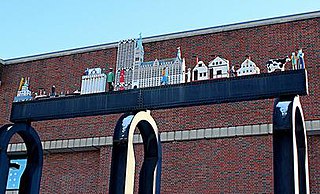
"Milwaukee" is a public artwork by Cleveland, Ohio artist George Mossman Greenamyer, located at the University of Wisconsin–Milwaukee; Golda Meir Library, Milwaukee, Wisconsin, United States of America.
Gogebic Taconite is an iron-ore mining company in development stage, based in Florida, with a presence in Hurley, Wisconsin. The company, owned by the larger mining organizations, Cline Resource and Development Group, is at the center of a dispute among politicians, community groups, environmental organizations, Native American tribal councils and various stakeholders because of a proposed mining project scheduled for operation in Iron and Ashland counties in northern Wisconsin.
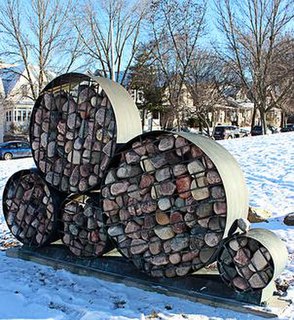
Walk Like a River is a public sculpture by Peter Flanary located at Riverside Park on the east side of Milwaukee, Wisconsin. Walk Like a River consists of three sculptures--Drop,Gather, and Flow--installed throughout the park. The group of sculptures was commissioned by the Urban Ecology Center, a nonprofit organization.
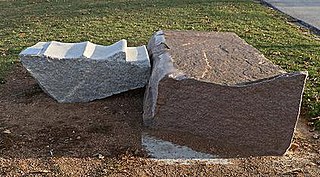
Edge Elements is a public sculpture by Richard Hansen located at South Shore Park on the south side of Milwaukee, Wisconsin. Edge Elements is a series of five sculptures. The group of sculptures was commissioned by the Milwaukee County Percent for Art Program.
The geology of Wisconsin includes Precambrian crystalline basement rock over three billion years old. A widespread marine environment during the Paleozoic flooded the region, depositing sedimentary rocks which cover most of the center and south of the state.



